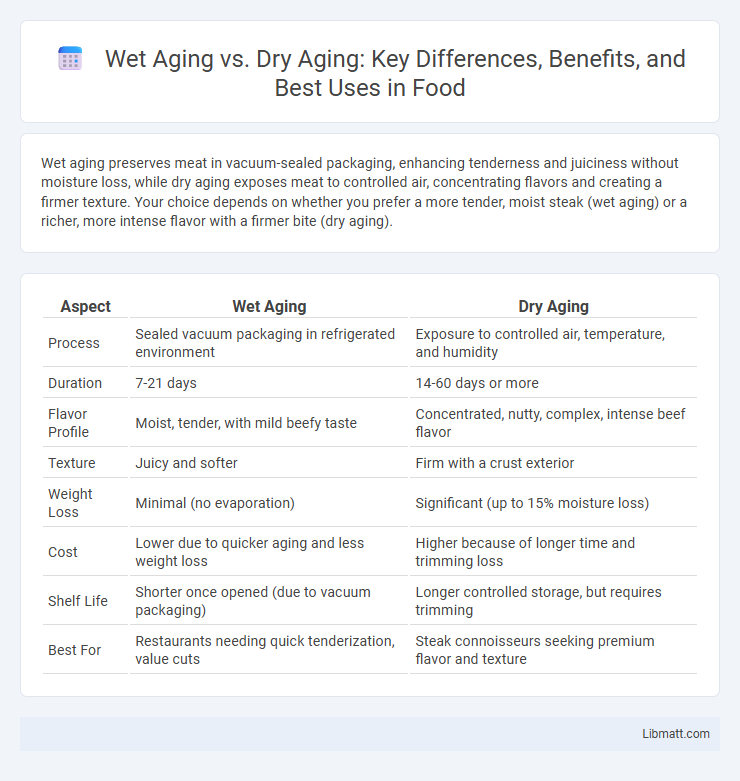Wet aging preserves meat in vacuum-sealed packaging, enhancing tenderness and juiciness without moisture loss, while dry aging exposes meat to controlled air, concentrating flavors and creating a firmer texture. Your choice depends on whether you prefer a more tender, moist steak (wet aging) or a richer, more intense flavor with a firmer bite (dry aging).
Table of Comparison
| Aspect | Wet Aging | Dry Aging |
|---|---|---|
| Process | Sealed vacuum packaging in refrigerated environment | Exposure to controlled air, temperature, and humidity |
| Duration | 7-21 days | 14-60 days or more |
| Flavor Profile | Moist, tender, with mild beefy taste | Concentrated, nutty, complex, intense beef flavor |
| Texture | Juicy and softer | Firm with a crust exterior |
| Weight Loss | Minimal (no evaporation) | Significant (up to 15% moisture loss) |
| Cost | Lower due to quicker aging and less weight loss | Higher because of longer time and trimming loss |
| Shelf Life | Shorter once opened (due to vacuum packaging) | Longer controlled storage, but requires trimming |
| Best For | Restaurants needing quick tenderization, value cuts | Steak connoisseurs seeking premium flavor and texture |
Introduction to Wet Aging and Dry Aging
Wet aging preserves meat by vacuum sealing it in airtight plastic bags, allowing natural enzymes to tenderize the muscle over a period of days or weeks while retaining moisture. Dry aging involves hanging meat in a controlled, refrigerated environment with precise temperature, humidity, and airflow, which concentrates flavor through moisture evaporation and enzymatic breakdown. Both methods enhance tenderness and flavor, with wet aging focusing on juiciness and dry aging emphasizing depth and complexity.
What Is Wet Aging?
Wet aging is a meat preservation process where beef is vacuum-sealed in airtight plastic packaging to retain moisture and enhance tenderness. This method allows enzymes to break down muscle fibers over a period ranging from a few days to several weeks, improving flavor without the weight loss associated with dry aging. Your choice of wet aging ensures juicier cuts with a milder, less concentrated taste compared to dry-aged beef.
What Is Dry Aging?
Dry aging is a traditional beef aging process where primal cuts are hung in a controlled, refrigerated environment with precise temperature and humidity for several weeks. This method enhances flavor and tenderness by allowing natural enzymes to break down muscle tissue while moisture evaporates, concentrating the meat's taste. Dry-aged beef typically develops a rich, nutty flavor and a firmer texture compared to wet-aged beef, which is vacuum-sealed and aged in its own juices.
Key Differences Between Wet Aging and Dry Aging
Wet aging preserves meat by vacuum-sealing it in plastic, allowing enzymes to tenderize the meat in its own juices, resulting in a moister texture and shorter aging time, typically 7 to 21 days. Dry aging exposes meat to controlled air in a refrigerated environment, promoting moisture evaporation and flavor concentration, which produces a more intense, nutty taste and a firmer texture over a longer period, often 21 to 60 days. Your choice depends on whether you prioritize juiciness and tenderness (wet aging) or complex flavor development and texture (dry aging).
Flavor Profiles: Wet-Aged vs Dry-Aged
Wet-aged beef retains a more metallic, bloody flavor due to its sealed, vacuum-packed environment, preserving moisture and resulting in a tender but milder taste. Dry-aged beef develops complex, nutty, and earthy flavor profiles as exposure to air allows natural enzymes to break down muscle fibers, concentrating taste and intensifying umami notes. Your choice between wet aging and dry aging impacts the balance between juiciness and flavor depth, with dry aging favored for robust, savory richness and wet aging prized for consistent tenderness.
Texture Comparison: Wet-Aged vs Dry-Aged
Wet-aged beef retains moisture, resulting in a tender, juicy texture that is softer and less chewy. Dry-aged beef undergoes moisture evaporation, concentrating flavors and creating a firmer, denser texture with a crusty exterior. Your choice depends on whether you prefer a moist, tender bite or a more intense, chewy meat experience.
Cost and Accessibility
Wet aging is generally more cost-effective and accessible due to its use of vacuum-sealed packaging and refrigeration, requiring less specialized environment control. Dry aging demands a controlled, temperature- and humidity-monitored space, driving higher costs and limited availability mainly to upscale restaurants and specialty butchers. Consumers seeking affordable aged beef often opt for wet-aged meat, while dry-aged products remain premium due to aging losses and facility expenses.
Shelf Life and Storage Considerations
Wet aging involves vacuum-sealing meat, which extends shelf life up to four weeks by preventing exposure to air and bacterial contamination. Dry aging requires controlled temperature and humidity, typically 34-38degF and 75-85% humidity, with a shelf life of about two to four weeks due to moisture loss and surface mold development. Understanding these storage considerations helps you maximize flavor while ensuring safe consumption.
Best Cuts for Wet Aging and Dry Aging
Prime cuts like ribeye, strip loin, and sirloin yield the best results with dry aging due to their high marbling and thickness, allowing enzymes to tenderize the meat while concentrating flavors. Wet aging suits leaner cuts such as chuck and round, as vacuum-sealed packaging retains moisture and enhances tenderness without the risk of excessive drying. Choosing the appropriate aging method depends on the cut's fat content and muscle structure to optimize flavor and texture profiles.
Which Aging Method Is Right for You?
Choosing between wet aging and dry aging depends on your flavor preference and cooking goals. Wet aging, which seals beef in vacuum-packed bags, preserves moisture and offers a milder taste, ideal for tender cuts and quick preparation. Dry aging exposes meat to air in controlled conditions, enhancing tenderness and developing a rich, nutty flavor, perfect for those seeking a more intense beef experience.
Wet Aging vs Dry Aging Infographic

 libmatt.com
libmatt.com